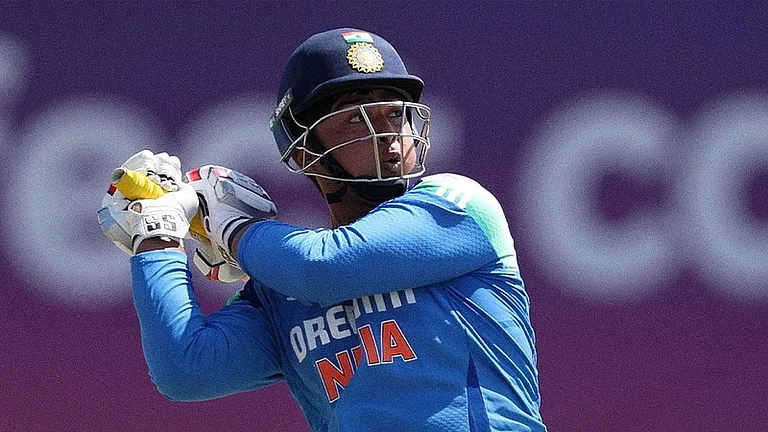1995. The Internet officially arrived on a Tuesday—and everything was shut: it was August 15, Independence Day. Roughly five years after the Internet had been let loose upon the world, the Videsh Sanchar Nigam Limited (VSNL) squeakily pushed and shoved open its Gateway Internet Access Service (GIAS) and let us, trepidant and self-assured, in. The VSNL had spent a meagre Rs. 2-2.5 crore to launch the service. It showed. It was terrible. Calls would disconnect and obdurately refuse to reconnect. Systems crashed. Imagine a stampede of gremlins.
I was there. Among the first 100 ‘citizens’ to get Net-connected in India. It should’ve been a red letter day—technically and governmentally, was—but what a slender thread of spider silk for us to hang on to! That dial-up TCP-IP connection snapped every five minutes (often less), reintroducing into the middle of catatonic perusal a rage-inducing, adenoidal dial-tone and an avalanche of digital snow.
ALSO READ: Silver Jubilation
But, hey, it was the Internet (capital ‘i’ those days). I had a data account. I had an aam janta landline. I had a fearsome speed of 9.6 kbps. I had a rattly, assembled 486 desktop (it would jam up every week or so, because most computer-assemblers in India were glorified analog garage-mechanics with vaulting digital ambitions in inverse proportion to their nous—and branded PCs were batshit expensive). The world was my oyster. I opened it, inexhaustibly surfing porn pages for a month, boning up on the dramaturgy of the (no-longer) taboo.
The bill for the month came to a head-exploding sum. The basic cost for me, a certified ‘professional’, was a not-unaffordable Rs 5,000 a year (payable lumpsum) plus extra per month for any incautious freewheeling beyond 20 hours a month. I ended up paying Rs 2,500 that first month. For years thereafter, the Net would go on to turn me into a nervy bankrupt every month. I became a red-eyed, scruffy, shuffling Net-junkie. (According to the Urban Dictionary, “Net-junkies tend to not have lives, although, on rare occasions, one of them unwittingly downloads it from the internet.”) I still am.
ALSO READ: Postcards From The Newsroom
Addiction to one drug is often a gateway to a minefield of cognate drugs. Porn palls, eventually. A couple of months later, all around me was a sea of info-porn. Sprawled before me were fledgling, shaky, but loquacious, word-heavy, information-laden websites. Information one had thought didn’t, or couldn’t, exist. Not only all gratis, but also dependent on page visits for their raison d’être. I’d never before felt so informatively mollycoddled.
And they were coming up at the rate of, first, 10, then 25, then 50, a day. It was a heady if confusing time to be a journalist. In a slow-trodden year or so, the Indian press caught on to the inevitability of the internet as the near-future’s driver of information exchange, trafficking and data-broking, and cobbled together websites that were altogether hideous facsimiles of foreign sites.
Despite its leaky tangle-web, VSNL garnered 10,000 avid subscribers within the first six months. Then things proceeded to fall apart. Despite the introduction of Integrated Services Digital Network (ISDN) access in 1997, for the next decade, even as speeds ramped up around the world, in India they lolloped along at less than 56 kbps on dial-up.
ALSO READ: At Swim, Two Birds Perched On Latticed Sites
We were behind the cyberconvoy. Look at it this way: in 1995, there were 23,500 websites worldwide; a year later, there were 2,57,601—a year-on-year increase of 996 per cent! It wasn’t just us on the slow coach. When The New York Times published its guide to ‘Site-Seeing on the World Wide Web’ on January 3, 1995, it didn’t have its own website. (Which just speaks about journalism’s legendary late adoption of technology, given that the world’s first website went live on August 6, 1991, at CERN.) Rediff was the only domain name registered in 1996 in India. When Shaadi.com was started in 1998, it had only 677 profiles. In 2019, there were over a million.
Today, 380 websites are born every minute, or 5,47,200 every day—although over 85 per cent of them will end up inactive. And because the internet never forgets, these will remain eternally derelict memorials to rusted intent and flaky ambition. You’d never think it, but the internet is the world’s most unforgiving graveyard. It leaves alive only one-seventh of its population: 1.6 billion of its 1.9 billion websites, built over three fevered decades, are forever kaput.
***
In those years, of course, there wasn’t the remotest sign of internet attrition. Things were looking up: newspapers and magazines began developing their websites almost before they knew what to do with them. A leading daily heard of my trawling skills—I had upgraded to a stonking Pentium, also assembled and whimsical—and commissioned a weekly column in which I had to write about two new websites. It paid well; the editor, although a Luddite, recognised that the Net might be an unknown quantity but that it was here to stay.

Soon, my column had peeled off from being po-faced serious into describing websites that typified the kaleidoscopic puckishness that was metastasising through cyberspace, kicking up website ideas you couldn’t imagine unless you happened to chance upon them or followed, unconcerned about destination, a linked trail of breadcrumbs punctuated by branching spoors and even whiffs of strange, distracting moieties. There was a cobbled-together, spit-and-gum, punk-like squatter’s exuberance to the Net. Monster architecture, the product of megacorp lebensraum, had yet to come up. Hypercontrolled data superhighways were unready, although the intent to have them had made itself known. Until then, out on a promenade, you could run into an intellectual or subcultural fellow-traveller round the next link.
ALSO READ: The Bully Wears A Tailored Suit
In 2000, Indian investigative journalism came of age—via a maverick website, tehelka.com. That’s where I learnt, and taught, my investigative chops. The logistics of handling a fat, multichannel website with running 24/7 uploads were as terrifying as they were exhilarating. And our serial investigations pushed a corrupt government to the wall. Between 2000 and 2003—when the Net-only tehelka shut shop, haemorrhaging from a vindictive government’s thousand cuts—the internet in the subcontinent shook itself wide awake, even digging in against the anticipated armageddon of the 20th-century fin de siècle: the Y2K bug.
In 2000, India had a mere 5.6 million Net users (or 0.5 per cent of the population). By 2003, this had grown to 18.7 million (1.7 per cent), and by 2005 to 27.3 million (2.4 per cent). In 2019, the number was 719 million. But quantitative growth exacted its price. What we conquered by our volubility and verbosity, we lost by our transactional incivility. We drowned the analog art of communication in the digital craft of it. And the internet and the Indian media have been at the very heart of the digital de-ethicisation of the country.
***
At the turn of the millennium, there were some faint signs of the interpersonal chaos to come. In 1999, Yahoo! acquired the online community Geocities for a stunning $4 billion. By then, I’d long had a couple of utterly pointless, ego-feeding, no-good sites running on it (which have, fortunately, disappeared into the vast, anonymising maw of cyberspace). In 2004, Google launched Orkut, a site that would go on to define the structure, intent and failings of the social media so conclusively that they remain unamended—and unemended—to this day. Just a year later, racist hate-speech exploded among the Brazilian community in Orkut (which was built, ironically, by a man who described himself as “born in Turkey and grew up in Germany where I was a geeky Muslim boy in a class of blondes”, and who was “back in Turkey in middle school...the funny guy with the German accent”). In 2006, the Brazil police filed a case against Orkut, and the Federal Public Ministry of São Paulo subpoenaed Google to explain itself. In hindsight, it all reads so presciently about the social media mess of today, and the efforts of some governments to set the SM leviathans in order even as other governments seek to energise and exploit them.
ALSO READ: Can Machines Talk?
In February 2007, SM nastiness came to India. An airhostess moved a Delhi court complaining that someone had opened an account in Orkut in her name with a self-description as a “sex-starved woman”. The same month, the father of a South Delhi schoolgirl complained to the Cyber Cell of Delhi Police’s Economic Offences Wing that a fake profile in the social networking site had resulted in an avalanche of lewd calls. Orkut shut shop, but the problems with unfettered and untutored access to ground-level hitech migrated to other, bigger, ostensibly more democratic social media platforms.
There is an almost uncanny parallelism in the growth of the internet and that of mobile telephony in India. Exactly 25 years ago, too, the first-ever mobile phone call was made in India. It was between West Bengal chief minister Jyoti Basu (an ideological antitechnologist) ensconced in The Writer’s Building in Calcutta, and Union Telecom Minister Sukh Ram at Sanchar Bhavan in New Delhi.
India skipped the entire analog generation of mobile phone services and went straight to GSM and 2G, to the very heart of the internet. This fortuitous shortcut would go on to map our access to the Net as majorly mobile-based, phenomenally inexpensive, and, therefore, uncontrollably disruptive (not always in a good way, unlike the corpogeek exaltation of disruption as intrinsically beneficial).
***
But wait, it was triplets! And hold the congratulations....
On September 30, 1995, a gaunt, bearded young man spoke these words, “Namaskaram, pradhanavarthagal” (Namaskaram, here’s the main news) on Asianet. And thus, in that very same season, India also saw the birth of private TV channel news. It would gather inexorable momentum and menace—bringing us, a quarter-century later, by what seems like unwavering force majeure, to today’s cacocracy. In opportunistic concatenation, the Net, mobiles, and TV newschannels would go on to make for the perfect storm of information, misinformation and disinformation, a storm so frenetic and ferocious that it would make, to the commonplace user, one indistinguishable from the others.
ALSO READ: Future Grid
The mobile is by now a catchall carry bag of information access. According to the Broadcast Audience Research Council (BARC) report What India Watched 2019, TV viewership stood at 762 million—which was actually an 8.85 per cent decline from the 836 million viewers the previous year. Meanwhile, smartphone ownership was 502 million in 2019, and is estimated to grow to about 760 million in 2021. In effect, the likelihood that more and more Indians are catching their ferociously discordant TV newschannels on YouTube and other platforms is very high. The dynamics of political (but not socioeconomic) equalitarianism plus low-cost hitech plus fingertip information access and dissemination are irrepressible. The virtual self-propulsion of a feudodemocratic India still fighting its mythohistorical way out of classist depredations into a future, unfamiliar mode of human transaction has come at a political cost that could set us developmentally back by a decade, if not more.
Net-access is spreading at breakneck speed. As of November 2019, thanks to phenomenally low data costs, ruromofussil Net users (227 million) had overtaken urban Net users (205 million). More significantly, 71 million (or 16.5 per cent) of these were children aged 5-11, using the phones of family members to go online. These are pre-pandemic figures: few would disagree that more children have been going online thusly in the time of the virus, most often to attend classes, but also because stay-at-home brings with it the debatable benefits of easier, and constant, access to devices previously sandboxed by adult observation.
And yet, there exists in India far more space for Internet Lebensraum. Net penetration here is 40 per cent, compared to 61 per cent in China and 88 per cent in the US. A ripple effect is in progress that will, I fear, subsume the entire country under an information and data overload.
***
A silver jubilee is hardly something to scoff at. The internet is everywhere you look, as is the nouveau média. A multi-yottabit superocean without end surrounding what the physicist Alfred Wegner called in 1912 an “Urkontinent”: an anthropophagous data-megafactory the size of all the world’s continents joined together. If these are unfamiliar terms today, they will not be tomorrow, when you can expect qutrits to replace qubits, and ternary to replace binary in everyday geek parlance. And this, hand in glove with the inevitable quantum PCs, is when one can safely—or, rather, hazardously—expect the internet, and the quotidian information driving it, to explode and implode at the same time. You think you’ve met chaos? Wait a few years.
Meanwhile, 25 years after I met the internet with boundless confidence and what would count today as literally horse-drawn technology, I’m doing things I’d never imagined possible. That I wrote this article on a mobile phone, with 42 windows open across three browsers—including the Tor anonymising browser—and nary a hint of lag, is the least of it.
Yesterday, I downloaded a deepfake app on my phone, and jiggled an image of a certain recalcitrant, turnip-topped head-of-state of a certain global power into admitting that he is—I’m editing out the purple prose here—a flashy tinpot with no electoral locus standi. You’d think this wouldn’t make for news. But here’s the thing: if I put it out there on the Net for viral consumption, it would make for disinformation. Marry to his mug a facsimile of him speaking (in his accent, his unique locution) the very purple prose I mentioned—and you’d have artificed fake news indistinguishable from videoed real news. Deepfake is the next new juncture between the Net and the media. I am supremely confident that India will take to it like a shark to a superocean.
ALSO READ
Kajal Basu is a senior journalist based in Calcutta. He bought his first 486 in 1995 in order to write science fiction...and has since been distracted by fact.























